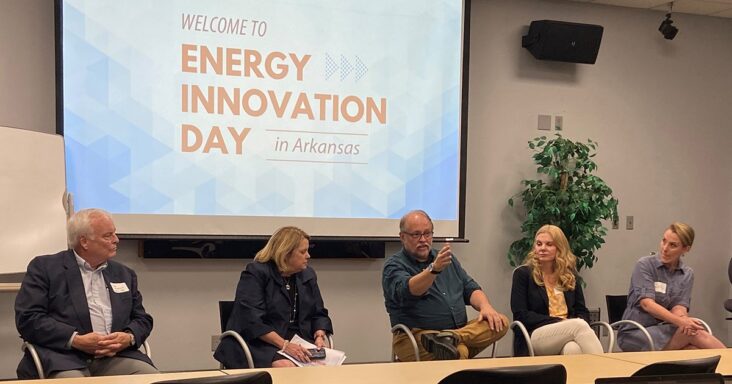State leaders highlight renewable energy projects, hydrogen hub
by June 18, 2023 9:13 am 1,386 views

Glen Hooks, policy manager for Audubon Delta, speaks during a Q&A session with energy leaders as part of Energy Innovation Day at the University of Arkansas in Fayetteville.
Arkansas energy leaders recently provided updates on energy-related projects and learned about federal funding opportunities that could help to make them a reality.
The discussion was a part of Energy Innovation Day on Thursday (June 15) at the Arkansas Research and Technology Park at the University of Arkansas in Fayetteville. The event was hosted by the Arkansas Small Business and Technology Development Center, the Arkansas Advanced Energy Association, and UA divisions of Economic Development and Research and Innovation.
Lisa Perry, senior manager of Energy Services at Walmart, said the Bentonville-based retailer’s utility expenses, especially electricity, comprise the company’s second-largest expense behind labor costs.
“Unfortunately, I cannot tell you the exact number that we spend on electricity just in the U.S. each year,” Perry said. “But I will tell you it’s…mind-boggling big. So part of what we do in our department is look for ways to be more energy-efficient within our facilities, within our stores [and] within our distribution centers.”
She also explained the company’s plans to invest in its own DC fast chargers for electric vehicles (EV) at Walmart and Sam’s Club stores and plans to eliminate its carbon emissions globally. The company’s existing EV chargers are owned by third-party providers, but she said the company is blamed when they don’t work.
Perry said the company expects to have its first tranche of DC fast chargers in place by next year. The goal is to have the chargers available at thousands of Walmart and Sam’s Club stores by 2030. The chargers are expected to be near storefronts but still within the parking lot. Some charging stations could include canopies lined with solar panels. Batteries might be used to help store the energy.
She also noted the company’s plans to use electric, hydrogen and compressed natural gas (CNG) trucks to help the company transition to zero emissions globally by 2040. Other milestones in reaching the goal include being half powered by renewable energy in two years and powered by 100% renewable energy by 2035.
“Walmart has the largest privately-owned trucking fleet in the country,” Perry said. “We have everything from small delivery vans all the way up to the big tractor-trailers… So we’re looking at different technologies, hydrogen being one…very excited to hear about hydrogen hubs.”
Tom Waggoner, managing director and CEO of Syntex Industries LLC, described one of the challenges with hydrogen trucks as which comes first: the hydrogen fueling stations or the trucks. He proposed building fueling stations at 200-mile intervals along interstates across the region. Smaller stations could be built to fill the gaps.
“Hydrogen trucks aren’t going to flood the interstates in the next five years,” he said. “It’s going to take five to 20 years for this market to develop… We’re hoping we can get this done along I-40 from Oklahoma City to Memphis and Kansas City to New Orleans and really get a hub, a transportation hub started in a meaningful geographic area.”
Waggoner also discussed the company’s plans to build a hydrogen power plant in Clarksville. The more than $250 million plant is expected to generate more than 500 megawatts of emission-free electricity, boost Clarksville economically and create more than 100 full-time positions.
Waggoner said hydrogen power can be produced using inexpensive wind power when there’s an excess supply. And when it’s limited, such as when the wind isn’t blowing, hydrogen power would be available to power the grid.
“It’s a multi-phase project,” he said. “That power plant alone will add 100 to 150 jobs. We’ll bring in an ethanol plant that will add another 150, and we’ll bring in an ammonia plant that’s roughly 120. The impact of just those three businesses…is going to add about 500 jobs, high-paying jobs, to the community of Clarksville and the surrounding area. When you add on top of that the service jobs that come with it, the ancillary jobs of engineers, architects, designers, and mechanics…the economic impact is liable to be over $1 billion within the next 10 years.”
Becky Keogh, infrastructure coordinator for the state of Arkansas, said to expect an announcement in September on whether federal money will be provided for the HALO Hydrogen Hub, a bipartisan, three-state partnership between Arkansas, Louisiana and Oklahoma. The money would come from the $1.2 trillion infrastructure law, or Infrastructure Investment and Jobs Act (IIJA). The project could receive up to $1.25 billion for technology investments in the three states.
Keogh also discussed state goals and investment priorities and other grant programs available to Arkansas through the IIJA and Inflation Reduction Act.
Glen Hooks, policy manager for Audubon Delta, highlighted one of the programs in the latter law that can help electric cooperatives build renewable energy plants as they look to replace retiring coal-fired plants.
“If we do this right, it means a lot of good things,” Hooks said. “It means lower electric rates. It means healthier communities because we’re going to go to clean energy instead of dirty energy and all the pollution that comes with that. It’s going to mean good-paying jobs which always is the kind of language everybody likes to speak… It means dramatically lessening greenhouse gas pollution… We’ve got to make this transition to clean energy, and we’ve got to do it pretty quick because…we’re on the clock.”
